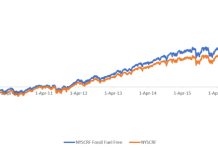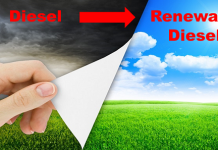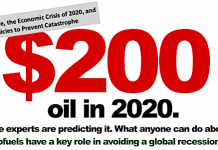“So much for peak demand – try 134mb/d by 2030.” That was the startling conclusion dispatched from the ivory tower recently by Joyce Dargay, a British transport econometrics professor, and Dermot Gately, an American economics professor. I’ll present their conclusions and then discuss the implications.
Their report is available here (pdf). The main conclusion is that the low hanging oil fruit has already been picked after the 1970’s oil shocks. From 1978-85 OECD fuel oil consumption dropped by 7mb/d and then from 2003-2008 by another 2mb/d. The share of fuel oil in OECD consumption has fallen from 44% to 16% today, so there is not much left to cut. The authors estimate the price and income elasticities of different components of oil consumption in the OECD and other blocs.
The OECD oil demand response to higher incomes over the last 40 years is shown in Figure 1. The equi-proportional growth lines indicate the slope oil demand should have if it is proportional to income growth. It can be seen that fuel oil dramatically drops off, however per capita transport & other oil remained reasonably correlated with income growth.

It shouldn’t come as much of a surprise that transport oil consumption goes up with income. For example, Figure 2 shows a very high correlation between Irish transport energy and GDP:

The authors then estimated the price and income elasticities of oil in different blocks: China, Oil Exporters, Income Growers, and other countries. They combined these segments into a “rest of the world” umbrella. They then contrasted their 2030 oil demand projections with the various scenarios of the DOE, IEA & OPEC. For example, the DOE’s projections are shown in Figure 3.

Figure 4 shows the authors’ projections, in per capita daily oil consumption:

Can you spot the difference? The OECD and FSU (Former Soviet Union) projections are reasonably close. It’s the rest of the world line that is much different in the DOE’s projections. The DOE suggest that China, India, OPEC etc will grow at one fifth of their historic oil demand rate, despite higher income growth. Instead of the DOE’s 0.56% growth rate, the authors’ projections finds close agreement with the historical growth rate of 2.54%. It’s not exactly unreasonable to expect the rest of the world to (attempt to) raise their consumption of oil from 1 liter per day to 2 liters per day, especially if their income is rising. The OECD slurps over 6 liters per day, after all.
The difference between the DOE’s and the authors’ projections is some 20mb/d, or two Saudi Arabias. So in 2030, a plausible buisness as usual scenario suggests world demand at 134mb/d. As for supply, well Figure 5 shows the IEA’s flying pigs 105mb/d projection:

You can add in your favourite technology if you want: biofuels (currently 1.5mb/d), Coal-to-liquids (currently 0.15mb/d), Natural gas to liquids (currently 0.08mb/d), oil shale (0 mb/d), and sundry other technologies. They might give you several mb/d by 2030. The UK Peak Oil Task Force outlined future oil production as an undulating plateau at about 90mb/d (until 2020, at least). This leaves an approximately 40mb/d shortfall (134-90). How that 90mb/d gets allocated will be interesting. The authors don’t give an explicit breakdown by region, but Figure 6 shows roughly how an unconstrained scenario would look, with the dashed line indicating a possible supply cap:

The OECD and FSU remain flat, but the rest of the world tries to get to 2 liters per capita per day. How will the 40mb/d supply-demand burden be shared? Will the new Chinese middle class buy an EV instead of a car? Perhaps. US passenger cars and light trucks consume about 9mb/d, and the fleet turns over every 20 years of so. If they were replaced with super efficient small cars (assuming folks can get credit), you might get the same number of miles with 6mb/d. We already drive small cars in Europe, but there is still some scope for higher efficiency in vehicles, and high prices should hold the Jevons Paradox at bay.
The authors show that the price elasticity of oil exporters is very low, obviously enough, since they heavily subsidise domestic consumption. In Saudi Arabia, over half of electricity generation is from oil. Courtesy of Royal Decree M/56, utilities purchase oil for $3/barrel, or 7c/gallon. Not surprisingly the grid is at break point from the demand. They plan to double installed capacity from 30GW to 60GW by 2020, although some of that will be gas-fired.
Another kicker is that in the Middle East, peak water has arrived. Saudi Arabia in 2009 cancelled their plans for agricultural self sufficiency due to lack of water. Their aquifer is depleting at 7 times the rate it recharges. Hence they are turning oil into water by desalination. Were they to replace the annual depletion (700bcf/yr) with desalinated water, that would require 0.3mb/d per year. By World Bank estimates desalination demand could rise to 1mb/d in coming years.
These anecdotes just reinforce what anyone who’s followed oil knows – an export crisis is coming. Oil exporters will serve their citizens subsidised oil before exporting – it’s part of the unwritten petropact.
The marginal utility of a barrel of oil is greater in India or China than in the OECD. People still dream of owning a car in Asia. Figure 7 shows Chinese car sales:

This suggests that the burden of adjustment will fall heavily on the OECD. Our ability to invest in solutions depends on the economy tolerating the high oil price. You can read a 70 page paper on this subject by economics professor James Hamilton here (pdf). His conclusion was:
“the evidence to me is persuasive that, had there been no oil shock, we would have described the U.S. economy in 2007:Q4-2008:Q3 as growing slowly, but not in a recession.”
So triple digit oil prices are likely to hamper growth. This was also one scenario posited by the authors of the original study when they stated:
“Hence
this imbalance [40mb/d] would have to be rectified by some combination of higher real oil prices, much more rapid and aggressive penetration of alternative technologies for producing liquids, much tighter oil-saving policies and standards adopted by multiple countries, and slower world economic growth.”
It would be helpful if some governments actually recognised this reality. For now the response can be summed up as:

Eamon Keane is an Energy Systems Engineering masters student at University College Dublin with an interest in electric cars, rare earth metals and energy. He is looking for a job in the energy sector anytime after August 2010.







On a recent trip to Daytona Florida from Indiana I was stuck just how dependent we are on the automobile. F’in cars and pickup trucks as far as the eye could see. Any notion that electric cars could save us from the coming oil shortage is pure folly. This nation is heading off the side of a cliff and it’s not going to be pretty. I think U.S. car sales are like 10,000,000 a year? And Car companies are once again aggressively advertising big pickup trucks again, with free Hemi upgrades! The car mentality needs to stop now not later. Mass transit between major cities would be a good first step.
Peak production will continue to exceed peak demand. Kinda like the way peak gold production and peak sand production and peak diamond production and peak milk production and peak laptop production and peak everything production continues to outrun peak demand forever.
Calm down. Have fun. Buy an SUV. Stop worrying.